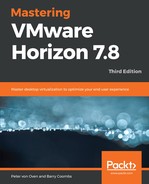Now that we have looked at some of the reference architectures, it's time to turn our attention to some of the components that are part of that architecture, namely our vSphere virtualization platform, and look at some of the high-level considerations for your design.
In this book, we aren't going into the intricacies of how to install and configure ESXi hosts. However, we will briefly discuss the recommendations on how you should configure vCenter Server, as well as the hosts and clusters for your Horizon environment.
It is technically possible to run your Horizon View and virtual server environments from one set of infrastructures, with one vCenter Server, and one or more ESXi clusters. By doing this, you could create several points of contention and a lot of difficulty during the time of upgrades.
As we discussed previously, there are two infrastructure areas when it comes to Horizon View: the management block that runs the vCenter Server, View Composers, and View Connection Servers, and so on, and the second one, which runs the virtual desktops themselves. The recommendation is that these two components are separated physically on different ESXi hosts and clusters, minimizing any risk of there being performance issues with the server components during heavy use periods or large desktop provisioning processes. From a licensing perspective, this is covered, as it is included with Horizon is the vSphere for desktop entitlement, which allows you to deploy as many ESXi hosts and vCenter Servers as you need to support your environment.
You should also run the Horizon View components on a different vCenter Server from your production vSphere environment. Separating the Horizon View components onto a separate vCenter Server will mean fewer clashes of priorities and prerequisites when it comes to upgrading either environment.
You should also run the Horizon View components on a different vCenter Server from your production vSphere environment. Separating the Horizon View components onto a separate vCenter Server will mean less clashes of priorities and prerequisites when it comes to upgrading either environment. The following diagram shows an example of how your virtual environments could be designed:

In the following section, we are going to look at the maximum values that can be configured.
